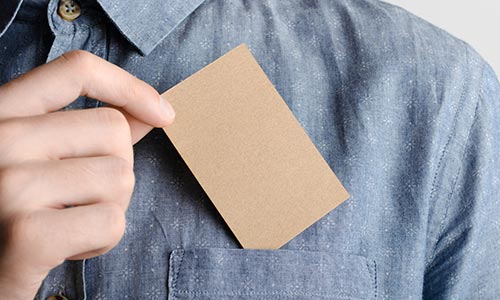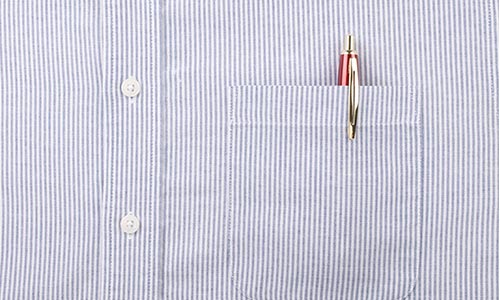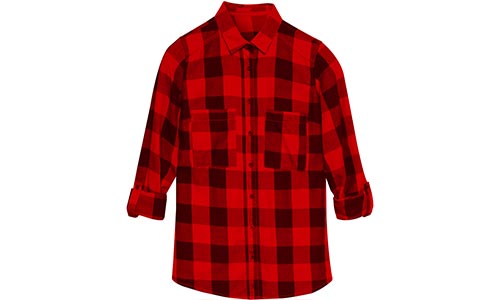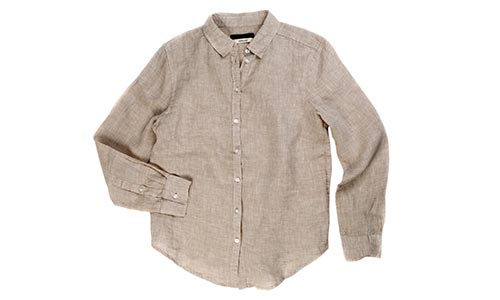
When it comes to men’s shirts, buyers have a lot of options. For example, the type of material chosen can dictate the comfort, fit, and ease of laundering the garment. When shopping for men’s shirts, consider the material as well as the advantages before buying; it may contribute to your overall satisfaction with the garment over time. Check out these options when choosing fabric for any occasion:
The most common fabric for men’s dress shirts is by far cotton. Cotton is also widely used in tees, another staple of most men’s wardrobes. it breathes so it keeps you cool and dry in heat, and warm in cold temperatures when layered over an undershirt. The material it produces is soft and easy to wash, and the price is often quite low. Be aware that it shrinks, so size accordingly and watch how you wash your products. Choose organic versions for a sustainable option or brushed cotton for additional luxurious softness on the skin.
Oxford
 Oxford cloth is a great choice. This material is coarse, yet comfortable, woven in a basket-weave type texture. Oxfords are commonly found in button-down styles, originally designed to be worn without a tie, and have become one of the most popular workday casual tops. This material is coarse, yet comfortable, woven in a basketweave texture. Delete/Duplicate. The traditional weave incorporates a subtle color with white thread in the cloth, leaving much of the garment natural and undyed. Oxford cloth clothes are easy to wash at home with your apparel, and a steamer or a light iron keeps them crisp and free from wrinkles. Several manufacturers now make wrinkle-free Oxford tops which never need ironing. This style can be great in many settings, from a casual workday to impromptu meetings with clients, it is the most casual of the standard professional styles.
Oxford cloth is a great choice. This material is coarse, yet comfortable, woven in a basket-weave type texture. Oxfords are commonly found in button-down styles, originally designed to be worn without a tie, and have become one of the most popular workday casual tops. This material is coarse, yet comfortable, woven in a basketweave texture. Delete/Duplicate. The traditional weave incorporates a subtle color with white thread in the cloth, leaving much of the garment natural and undyed. Oxford cloth clothes are easy to wash at home with your apparel, and a steamer or a light iron keeps them crisp and free from wrinkles. Several manufacturers now make wrinkle-free Oxford tops which never need ironing. This style can be great in many settings, from a casual workday to impromptu meetings with clients, it is the most casual of the standard professional styles.
Rayon
Rayon makes an exceptional dressy or casual man’s t-shirt, and it is a man-made material composed of cotton, trees, and plants. The result? A soft piece of clothing with amazing drape and a smooth feel. Rayon is lightweight so it is easy to wear in hot weather or during athletic activities. Rayon can resemble silk when worn but be warned: rayon can wrinkle easily. Also, it may not hold up over time with rigorous wear or frequent dry cleaning.
Pinpoint
 For business or work shirts, Pinpoint, or pinpoint Oxford, is an excellent choice. The weave is similar to Oxford, but uses finer fibers that are woven more tightly, creating a dense but silky-smooth fabric. Pinpoint is found often in formal, elegant apparel and more expensive products, to pair with a great suit and tie. Pinpoint is heavier than simple Broadcloth fabric, presenting an elevated version of the standard oxford, and is perfect for more formal occasions. This style is appropriate for larger office meetings and presentations, or first meetings with a client to give the best first impression.
For business or work shirts, Pinpoint, or pinpoint Oxford, is an excellent choice. The weave is similar to Oxford, but uses finer fibers that are woven more tightly, creating a dense but silky-smooth fabric. Pinpoint is found often in formal, elegant apparel and more expensive products, to pair with a great suit and tie. Pinpoint is heavier than simple Broadcloth fabric, presenting an elevated version of the standard oxford, and is perfect for more formal occasions. This style is appropriate for larger office meetings and presentations, or first meetings with a client to give the best first impression.
Poplin
Poplin is popular and has been used in shirting for generations. The soft feel and comfortable wear of poplin makes it a great choice for leisurewear or casual apparel. Poplin is frequently found in bold, vibrant color choices as it is easy to dye. Poplin has a smooth texture and is a lightweight textile.
Dobby
 Dobby cloth is crafted on the Dobby loom and is distinctive with its unique texture and patterns. Dobby is frequently compared with jacquard fabric, and Dobby is often found in striped or geometric styles. Dots are another common print woven into Dobby cloth. Dobby makes a good choice for a man’s shirt, though less formal and dressy than other varieties. Dobby may require special care when laundering, or simply take it to your favorite dry cleaner.
Dobby cloth is crafted on the Dobby loom and is distinctive with its unique texture and patterns. Dobby is frequently compared with jacquard fabric, and Dobby is often found in striped or geometric styles. Dots are another common print woven into Dobby cloth. Dobby makes a good choice for a man’s shirt, though less formal and dressy than other varieties. Dobby may require special care when laundering, or simply take it to your favorite dry cleaner.
Chambray is a popular choice for work apparel or other apparel that is exposed to the rigors of work, weather, or frequent wear. Chambray cloth is made with denser, thicker fibers to make a rugged product that will stand up over time. Chambray is excellent for casual apparel, usually woven to be dyed. This means many Chambray t-shirts can come in unusual colors, often requiring them to be the focal point in an outfit. When styled properly, these can present a type of hip-professional style that can be appropriate for many casual occasions and workdays.
Polyester
Polyester shirting may be the least expensive material as it’s a man-made synthetic fiber. Sportswear is often made from poly, and when added to other fibers, it makes them easy to care for and long-lasting. Polyester t-shirts hold their shape and don’t wrinkle, so they travel well. Don’t try to iron your poly shirts, as they could melt.
Broadcloth
 Broadcloth might remind you of poplin, but it is actually more formal and a bit more expensive. The weave is tight, creating a crisp look that is soft on the skin. The dense fibers hold up to regular wear, and threads are woven in an over-under pattern that often presents as a solid color to the eye. This material can take intricate patterns or designs, as the weave provides a clear and precise print. Broadcloth is the traditional business man’s dress-shirt cloth, worn with suit or jacket and tie.
Broadcloth might remind you of poplin, but it is actually more formal and a bit more expensive. The weave is tight, creating a crisp look that is soft on the skin. The dense fibers hold up to regular wear, and threads are woven in an over-under pattern that often presents as a solid color to the eye. This material can take intricate patterns or designs, as the weave provides a clear and precise print. Broadcloth is the traditional business man’s dress-shirt cloth, worn with suit or jacket and tie.
Jacquard
This is a traditional textile, well known for its colorful geometric prints, patterns, paisleys and florals. The patterns are colorful from both sides as they are woven into the material, not printed on one side. The pattern can sometimes be raised with a tone on tone effect and the garment tends to be dressy, often worn for parties and festive occasions.
Flannel
 Another popular choice in cold weather is flannel: who doesn’t like a cozy flannel shirt? Flannel is woven from fine threads creating a soft, brushed finish that feels comfortable to the skin. The surface texture is reminiscent of brushed twill, and flannel helps keep wearers warm in wintry weather. Flannel is great for casual ensembles, and not easy to dress up for formal occasions.
Another popular choice in cold weather is flannel: who doesn’t like a cozy flannel shirt? Flannel is woven from fine threads creating a soft, brushed finish that feels comfortable to the skin. The surface texture is reminiscent of brushed twill, and flannel helps keep wearers warm in wintry weather. Flannel is great for casual ensembles, and not easy to dress up for formal occasions.
Mélange
Mélange is French for ‘concoction’ or ‘blend’, which is exactly what it is. Mélange is an intriguing blend of both dyed and undyed threads, woven into a smooth and lightweight fabric that is used for high-end apparel. The cloth is very soft, luxurious, and has a Bohemian or organic appearance when worn. This material will merit special attention and care during laundering; talk to your favorite dry cleaner before throwing your Mélange clothes in the wash.
Twill
Twill is woven diagonally, creating a shiny or textured surface and thicker weave, which drapes well and is crease resistant. Herringbone twill has a distinctive pattern that is ideal for a shirt or suit. Twill is frequently used for quality men’s tops and works well for semi-formal occasions with dress trousers.
Linen
 Linen is a breathable textile that is comfortable to wear in both hot and cold environments, made in nature from the Flax plant. A bit coarser than cotton, Linen is used often in shirts, jackets, and suits. It should be mentioned that it always has a casual look, and wrinkles very easily. Lightweight and quick-to-dry, linen makes a good choice for summer apparel or outdoor wear and all year round in hot climates.
Linen is a breathable textile that is comfortable to wear in both hot and cold environments, made in nature from the Flax plant. A bit coarser than cotton, Linen is used often in shirts, jackets, and suits. It should be mentioned that it always has a casual look, and wrinkles very easily. Lightweight and quick-to-dry, linen makes a good choice for summer apparel or outdoor wear and all year round in hot climates.
Poly/Cotton Blend
Fabric blends combine the best of several worlds, a nice soft feel, with the ease of polyester. Generally, a poly/cotton blend is a 50/50 pairing, but not always so read labels. It is not uncommon to find some options that are actually closer to a 65/35 blend. This cloth is breathable and easy to care for, typically inexpensive. Poly/Cotton holds up over time and is comfortable to wear for dressy or casual occasions.
Tri-Blends
A Tri-blend is basically just that: a blend of three or more different types of material, usually a combination of cotton, polyester, and rayon. This hybrid weave brings the best qualities of these three widely loved fabrics to one item, resulting in comfortable wear that washes well and that looks expensive. Some blends may not breath well, depending on the cotton content, so consider this during particularly warm or humid weather. Also, be careful when ironing a tri-blend material as it can easily become damaged.
Developing an Image Through Style
Want to learn more about men’s fashions? How about style services, in general? Choosing cloth is just one element of the future as an image consultant; learn more about training for the field of style and image today.



